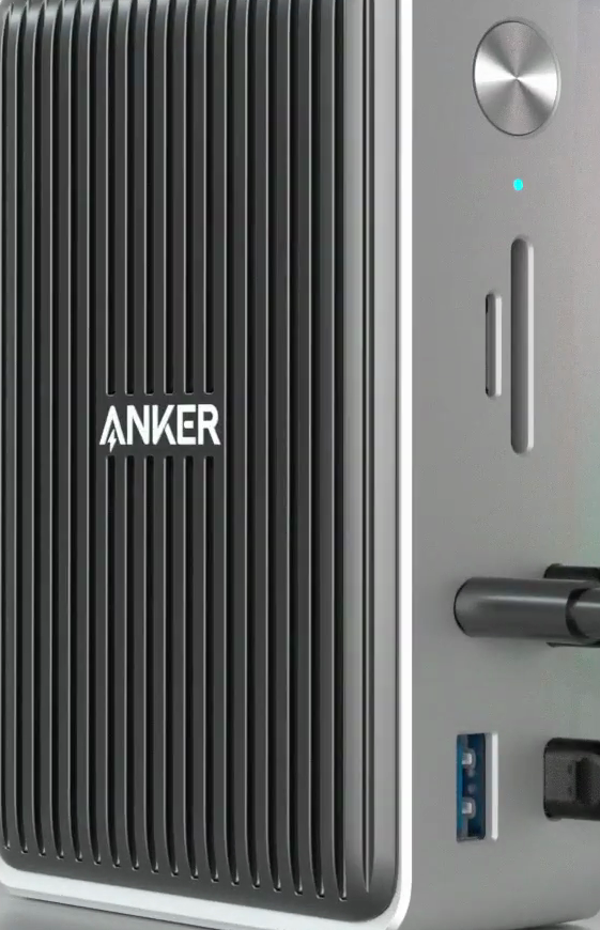Note: As an Amazon Associate I earn from qualifying purchases.
My impressions of the Anker 575 USB-C Docking Station 13-in-1 Triple Display (2024)
Introduction
I recently obtained the Anker 575 USB-C Docking Station and have been extensively testing it. As a heavy tech user for both work and personal use, finding an ideal docking station has been a top priority for me. I evaluated the Anker 575 on various devices to assess its suitability for a versatile and challenging tech setup.
Specifications
| Property | Value | Property | Value |
|---|---|---|---|
| Brand | Anker | Color | Gray |
| Hardware Interface | USB, Ethernet, HDMI, 3.5mm Audio | Compatible Devices | USB C |
| Total USB Ports | 4 | Product Dimensions | 3.5”L x 1.6”W x 4.9”H |
| Number of Ports | 13 | Item Weight | 13.1 Ounces |
| Total HDMI Ports | 2 | Wattage | 85 |
Photos
Click on photos to enlarge them:
Prices
Check prices of the Anker 575 USB-C Docking Station on:
Overall Design and Build

The Anker USB-C Docking Station 13-in-1 offers a practical design and strong construction, typical of Anker products. It boasts a wide range of ports to meet various connectivity requirements for a home office:
85W USB-C charging port
18W Power Delivery USB-C port
The device offers users extensive video output connectivity, featuring one DisplayPort and two HDMI ports. By incorporating both a DisplayPort and two HDMI ports, this setup grants increased flexibility in connecting multiple high-definition devices simultaneously.
3 USB-A ports for peripherals
1 USB-C data port
Ethernet port for wired internet
SD/microSD card slots
3.5 mm AUX for audio
DC input for power
This lineup allows me to connect all my devices directly without requiring extra hubs or adapters.
The heavy dock, although portable to some extent, may pose a challenge for frequent travelers due to its added weight. However, this heavy construction comes with advantages such as numerous ports for various devices and the ability to support simultaneous charging and data transfer. The heaviness could be perceived as a necessary trade-off for the dock’s stability and benefits.
The inclusion of an 85W power pass-through is beneficial as it allows charging my laptop without requiring a separate charger, keeping my workspace clutter-free. Moreover, the capacity to transmit video to three monitors is essential for efficient multitasking. However, note that your device must support either Multi-Stream Transport (MST) or Single-Stream Transport (SST).
Another minor issue is that this docking station, which can connect various devices including Macs, comes with limitations. Specifically, it only supports SST for macOS and iPadOS. Consequently, users will display the same content on all monitors if they use these devices. This might be disappointing for individuals aiming for an extended display setup.
Despite these factors, the high build quality and durability of the unit reassure me about its long-term use. The aluminum-like casing not only offers a modern appearance that complements most tech devices but also efficiently dissipates heat during operation.
Overall, the Anker 575 is a versatile docking solution that caters to various needs. Although it has some limitations in terms of device compatibility and portability due to its size, its extensive connectivity options and robust construction make it a valuable purchase for anyone seeking to upgrade their workstation.
Performance Across Various Devices

The Anker 575 USB-C Docking Station 13-in-1 has been an interesting experiment across my range of devices, showing varying levels of performance that I think are worth noting:
High Compatibility: Both my HP Laptop running Windows 10 and my Dell Inspiron 17 with Ubuntu 20.10 recognized the dock without the need for additional drivers.
Effective Functioning: The dock enabled the HDMI, Ethernet, wireless keyboard and mouse, HD camera, and other USB devices to work together seamlessly.
Power Delivery: The USB-C port with 85W capacity charges my ThinkPad Yoga efficiently while I work, reducing my battery anxiety.
Troubleshooting Required: I encountered some issues with the device at first, specifically screen distortion and detection problems. To resolve these concerns, I had to troubleshoot by readjusting the cable connections for proper resolution.
Minor Software Quirks: I’ve seen some discrepancies in display settings, particularly with resolution and refresh rates on Ubuntu.
When plugged into my ThinkPad Yoga, the laptop is highly effective in my home office setup due to its provision of all the necessary ports. Its robust construction conveys durability, and the power pass-through is sufficient to prevent battery concerns, ensuring a productive workday.
On my iPad Pro, changing displays is effortless for my workflow. I encountered some distortion on the screen but fixed it by reversing the USB-C cable direction. A minor issue with a simple solution.
Where it underperforms is the 4K video playback on my Dell Inspiron 17. Despite advertising sharp and clear videos, there are occasional interruptions with flickering. The dual HDMI ports limit output to 1080p resolution, which is acceptable but fails to reach the dock’s high-resolution capability.
In terms of MacOS suitability, the experience varies. Although it effectively powers devices and ensures connectivity, some users on MacOS 11.x and 12.x encounter high USB latency and network problems. These issues can be significant disadvantages for Apple ecosystem users.
I have been pleased with the dock’s ability to stay cool during prolonged use, an issue I encountered with previous hubs. The USB-C PD port at the front is a useful addition, functioning effectively when used with compatible devices.
Overall, device compatibility with the docking station has been extensive. My Windows laptops, Ubuntu machine, and Surface Pro 7 have all functioned effectively. However, wired network recognition remains a bit unreliable. The lack of driver installation simplifies setup significantly.
While the dock runs efficiently with both Thunderbolt and USB-C marked PD ports on my devices, I do find the sheer complexity of USB-C specifications slightly daunting—it’s a universal port that’s not always uniform in functionality. It’s important to keep in mind that mileage with this dock may vary depending on your laptop’s make and model.
In summary, the Anker 575 delivers good performance overall but presents some challenges when connected to high-resolution displays or MacOS systems.
Compatibility and Usability Concerns

The Anker 575 USB-C Docking Station offers various connection ports for users seeking versatility. I’ve used this dock, and while I was pleased with its multiple ports, I encountered some compatibility issues.
I am truly impressed by the device’s advanced functionality, which includes an 85W USB-C port for laptop charging and a separate 18W Power Delivery USB-C port that enables Simultaneous Charging. Simultaneous Charging is an indispensable feature during my hectic workdays as it allows me to charge my laptop and mobile device at once. This gadget’s convenience when powering multiple devices throughout the day cannot be overstated.
Connecting up to three monitors to your device is highly beneficial, especially when working with multiple applications or requiring extensive screen space for media display tasks such as video editing or graphic design. The DisplayPort and HDMI ports deliver satisfactory performance, making Media Displays a popular choice for professionals in these fields. However, it’s important to note that the refresh rates and resolutions capabilities of these ports can have certain limitations depending on the specific setup.
Universal SD Card Slots having both in a device is beneficial for content creators who frequently transfer footage from various cameras and drones. This feature allows for seamless compatibility with different types of SD cards, making it a valuable asset in the creative industry.
The dock’s display outputs can be occasionally finicky, despite its other strengths. This issue may manifest as compatibility problems with specific resolutions and refresh rates. To mitigate these potential inconveniences, it’s crucial to ensure that software and firmware are up-to-date for various devices and operating systems such as MacOS and Windows.
The docking station’s Plug-and-Play marketing can be misleading as the consistency in USB-C functions recognition across all devices is not guaranteed. This inconsistency stems from different implementations of USB-C on various laptop models, resulting in diverse user experiences. Nevertheless, it is important to note that the docking station works flawlessly with certain devices. However, for others, it may necessitate troubleshooting, posing a challenging experience, particularly for those who are less tech-savvy.
When selecting a docking station from the abundance of options available, it is crucial to be aware of the nuances of USB-C, Thunderbolt, and Power Delivery technologies. With a wealth of ports offering various capabilities, it’s essential to remember that not all connections provide identical functionalities when using this dock with different devices. The distinction between these technologies necessitates careful examination of your devices’ specifications before assuming full compatibility with this model.
Overall, from my perspective, the Anker 575 USB-C Docking Station is a versatile choice for my connectivity and charging requirements. However, I recognize its constraints. This docking station offers a balance between being all-encompassing and requiring some exploration to maximize its potential.
Final Verdict and Longevity

After spending ample time with Anker 575 USB-C Docking Station, I discovered it’s a suitable option for enhancing a laptop’s connectivity despite some imperfections.
Pros:
This device offers strong charging capabilities. It includes an 85W USB-C port suitable for laptops and a Power Delivery port of 18W for mobile devices.
Range of ports is vast and covers nearly every need I can foresee, from standard USB-A to HDMI and Ethernet.
Build quality feels durable and reliable, befitting of Anker’s reputation for quality products.
Cons:
Users may experience compatibility issues when running this software on MacOS or certain Windows setups. These compatibility issues could pose a concern for potential users who rely on these specific operating systems.
Resolution and refresh rate adjustments can be finicky, requiring additional steps to get settings right, especially on Linux systems.
The heft of the device might make it less than ideal for people seeking a portable docking solution.
The Anker 575 docking station showcases both durability and a versatile port selection, making it an ideal choice for current technology standards and various devices. Over the past year, it has consistently performed well during daily use without any noticeable degradation. With its extensive range of ports, users can connect multiple devices simultaneously, enhancing productivity and convenience.
Experienced issues with external screens not turning on, despite being recognized by the laptop. These malfunctions resulted in screen distortions and additional challenges for users. Solutions varied from updating software to adjusting cable connections. Regardless, these issues negatively impacted the overall user experience.
On the positive side, my ThinkPad Yoga setup delivers impressive performance. This dock excels at managing multiple devices such as HDMI, Ethernet, and USB peripherals concurrently. It’s a valuable addition to my home office setup, although its weight has led me to choose a lighter option for travel.
The Anker 575 USB-C Docking Station 13-in-1 functions as a powerful desktop expansion solution. Equipped with an extensive array of 13 ports, it addresses most connectivity requirements. Despite minor concerns that might warrant troubleshooting, the pros outweigh the cons. Disregarding portability, this dock is a worthy investment featuring a substantial 18-month warranty and prompt customer service from Anker. In essence, the advantages of the Anker 575 USB-C Docking Station 13-in-1 far surpass the disadvantages, making it an efficient enhancement to my tech setup.



